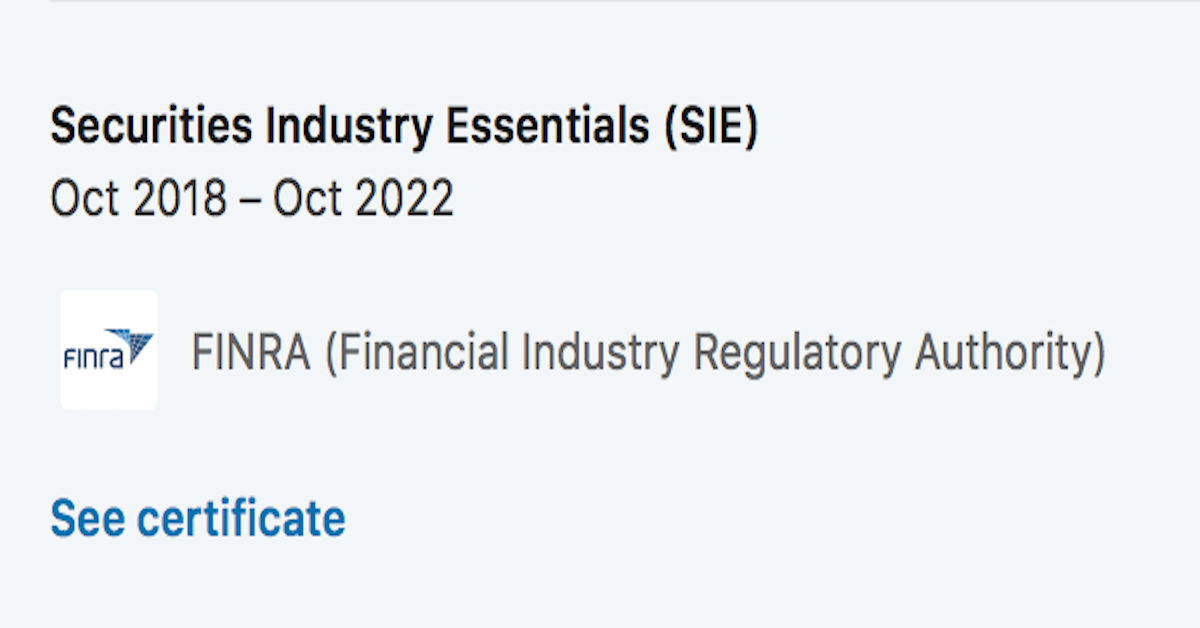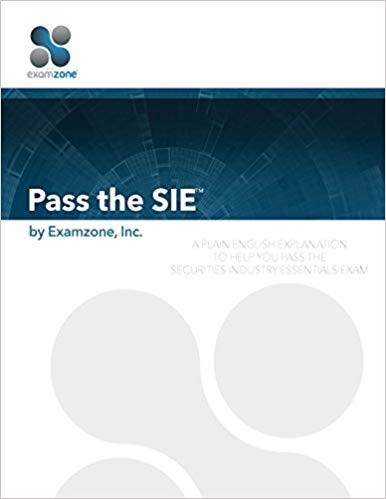This is my third post on credentialing, the first of which is about the Certified Bitcoin Professional Exam (CBP), the second on the Series 3 and Series 30 for commodities and derivatives trading and compliance.

The Securities Industry Essentials Exam (SIE) is a new test. It just became available on October 1st, 2018. The Financial Industry Regulatory Authority (FINRA) reorganized the initial securities exams in what I believe to be a smart improvement. Before the reorganization, the typical path to working in securities was to get your Series 7 (general principles/federal law) and Series 63 (state law) to become a General Securities Representative (though there were alternatives like the more limited Series 6.) In order to take these tests you first had to have a FINRA member sponsor you. In other words, you had to receive a job offer contingent on your passing those tests.
Now you no longer need a FINRA member sponsor to begin your securities credentialing. You take the SIE without a sponsor, proving that you know the basics, and then take the required ‘top-up’ exams like the Series 7 & 63 once you have a sponsor. I think this a prudent change for both the firms and securities rookies, so kudos to FINRA for making this switch.
I started with the Series 3 and Series 30 because they required no FINRA member sponsor. As I needed to learn more about commodities and derivatives for my work at Nori, this was a great start to formally learning the mechanics and regulations of that financial subsector. But I also really wanted a focused opportunity to test my knowledge of securities which was previously unavailable to me.
In studying for the SIE, there were many parts where my previous experience with commodities and derivatives helped me. For instance, compare the size of a study guide for the Series 3 vs. the SIE. The SIE study guide is much bigger and broader, so the Series 3 was an easier entry-point (though the study materials I read for the Series 3 were much more quantitative and trading-based.)
If you have the interest and are not in an immediate hurry to work in the financial sector, you might consider starting with the Series 3 and then, assuming you find the process valuable, move on to the SIE. You can do the Series 30 if you’d like, but it is more specialized in compliance and I think studying for the SIE and Series 3 offer a more immediately accessible knowledge set.
With that top level analysis out of the way, here is what I did to prepare for the SIE exam:
1. Have some trading experience
I cover this in the Series 3 & 30 piece. Having some understanding of how trading works really makes the entire financial space tangible to you. If you’re just studying the content abstractly it is a bit harder to incorporate this new information coherently.
Of course, the rule you must adhere to is to never put money in the market you can’t afford to lose, whether it be in legacy markets or cryptocurrency. There are trading simulators you can use as well to track your theoretical gains and losses which may better suit you as a novice.
I first started studying for the Series 3 with some trading experience under my belt, so I had a gut sense for the mechanics of trading which helped me a lot in making sense of my study guide.
2. Read study guides
I read two books in preparation for the SIE: Securities Industry Essentials Examination Course: SIE Exam Prep, and Pass the SIE.

I read Securities Industry Essentials Examination Course: SIE Exam Prep on my Kindle first, and it was just okay. It felt rushed to print and had a lot of typos. I’m not sure I’d recommend its use beyond a cursory skim, but I got it for only a few dollars so I gave it a read. In general, I think paper copies of study guides are superior to digital books, as you’re going to want to take their practice tests and to mark the text up in order to flip through and study later.
I next read Pass the SIE by Examzone, and it is quite good. I’ve also perused their Pass the 7. They crack jokes and it is a pleasurable experience. Given that these two books were all that were available, I’d strongly recommend Pass the SIE. I do see that there is a For Dummies SIE prep book coming out, but I’ve not read it and can’t speak to it, but that may be a viable way to go coming next year.
How I used Pass the SIE
There are four chapters by subject area, and at the end of each chapter are two quizzes: one in which you underline the correct answer in a sentence out of two options, and the other is multiple choice. At the end of the book there are two 75-question practice exams covering the breadth of the book’s content.
I read through the book cover to cover, marking sections that would need further review if they were new to me or confusing. I completed each chapter’s quizzes immediately after reading the chapter and would see how I did. I would mark questions I got wrong to remember to revisit them, then proceed to the next chapter.
I did not always do well on the chapter quizzes as some information I just didn’t pick up as key. Conceptually you should know how all of these financial instruments work and the tradeoffs of each of them well enough to explain to a friend greener than you are. Then, continue working through the book like this.
After I finished the last chapter (but not the very useful glossary), I took the first full practice exam without reviewing my notes. Predictably, it wasn’t a great score, but I wanted to get an accurate sense of what knowledge I had internalized at that point.
Now it’s time to review. Start at the beginning of the book and look at everything you’ve made notes on. Look at the questions you got wrong in the quizzes, learn the content you missed on them and the first full practice exam. Then visit the glossary for terms you don’t have in your brain, mark it up, and study well. I did this entire process a few times until I could tell where I was consistently failing and redoubled my efforts in those areas.
You may already be a bond champion, and you may have watched enough daytime tv to know everything about annuities, but perhaps the standardized formatting of options trading is opaque. Maybe you can’t remember which SRO or agency or piece of legislation does what. It is hard for me to tell you what may or may not be a tough learn as I’m coming at this from my own educational and experiential background. So make sure you take the practice tests without any help so you know where precisely are your weak points. Seeing your shortcomings will better prepare you the second practice exam, so be thorough and brutal in your self-assessment.
Then, take the second practice exam. Is it better than your first practice exam? It should be! You probably still got questions wrong (I did; don’t feel bad). That’s the content you really need to go back and master, but you should be ready or nearly ready to schedule your official SIE exam.
Conclusion
I find the structured learning of credential prep useful for my focus. I needed to learn more about securities, commodities, and derivatives for my work at Nori, and studying for these exams taught me a lot of valuable information. There is something about the deliberate practice of studying difficult subject matter over and over that helps internalize the information more than reading a few articles with no pressure. Whether you want to work in the securities industry or in a related field, or you just want to take responsibility for your financial future, I think the SIE is a beneficial certification. It may even look radiant on your LinkedIn.
In any case, good luck if you decide to pursue the SIE!




No comments:
Post a Comment